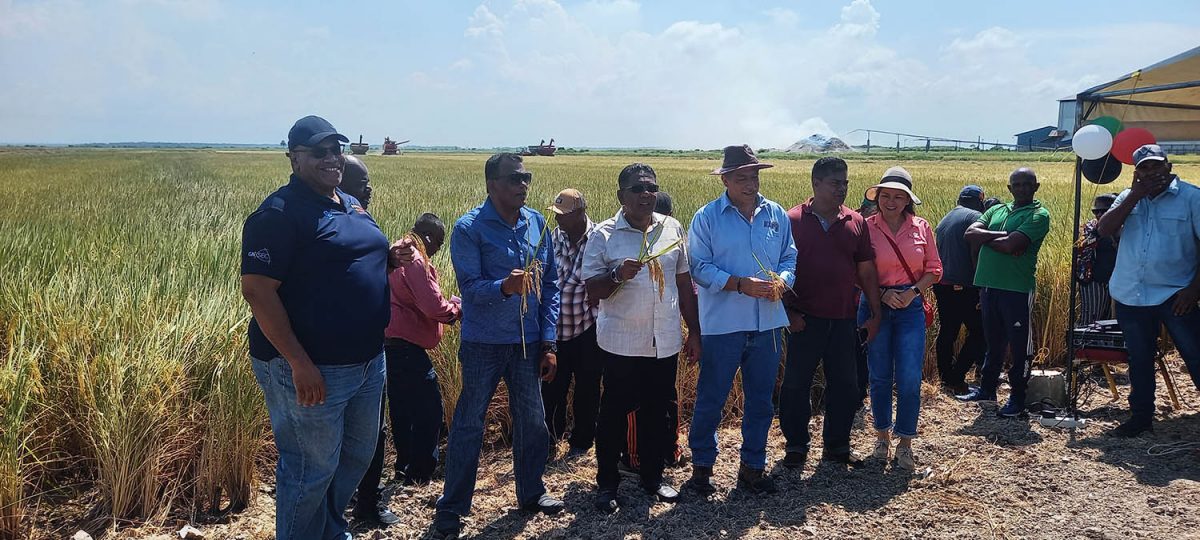Minister of Agriculture Zulfikar Mustapha yesterday stated that India’s ban on rice exports opens the market for Guyana’s grain and he is optimistic that the target for this crop will be surpassed.
Mustapha and a team of technical officers from the Ministry of Agriculture and the Guyana Rice Development Board (GRDB) along with regional officials from Region 6 yesterday witnessed the harvesting of the Bio-Fortified variety of rice grown by the GRDB at a farmer’s plot at Lesbeholden, Black Bush Polder, Corentyne.
Representatives from CARICOM and IICA were also a part of the activity.
At the location, Mustapha told the Sunday Stabroek when questioned that the India ban “will open more market for Guyana.”
Al Jazeera last month reported that three days after Russia pulled out of the Black Sea grain deal, India imposed a ban on July 20, 2023, on the export of non-basmati white rice. The move followed a ban on the export of broken rice, which was announced in September last year and is still in place.
According to the report, India’s reasons were domestic — rising food prices, high inflation, and fear of a rice shortage due to El Nino disruptions as the country heads into a festive season and elections. The ban’s impact is now being felt globally, with prices shooting up.
“Earlier rice was trading for US$550 per metric tonne, now prices are hovering above US$650,” Nitin Gupta, senior vice president of Olam Agri India Private Limited, one of India’s biggest rice exporters, told Al Jazeera, the report noted. Reuters last month reported that export ban by India, which accounts for 40% of world rice supplies, has taken out 10 million tons of supplies from the international market.
Meanwhile, rice prices in key exporting countries including Thailand and Vietnam have climbed around 20% since India’s move.
Last year, India banned exports of broken rice and imposed duty on shipments of various grades, ending the price stability that had lasted for more than a decade, Reuters said.
Mustapha yesterday said that “If India is withdrawing from the world market that amount of rice then Guyana rice will be in more demand so I am hoping that this crop that we can surpass the target that was set, already we surpassed last year’s target in the first half and for the half year we reach the target that was set by Ministry of Finance in its budget.”
Mustapha said that he is “very optimistic” that this crop they can achieve a yield between 6.2 to 6.5 tons per hectare, “and that will help us to produce more rice and if we produce more rice we will have more markets because those countries that normally take rice from India don’t have any import coming in from there (and) will look for other places.”
Notably, when Mustapha’s government returned to office, the yield countrywide averaged about 5.2 tons per hectare, and this crop yield is expected to be the highest recorded due to investments and interventions in support of the rice farmers by the government through the Ministry of Agriculture.
New markets
Mustapha disclosed that they have already seen new markets in parts of Europe opening up, “We have been getting new markets, places like the Netherlands and so asking us for more, and right in CARICOM too.”
According to Mustapha, “What we are trying to do in CARICOM is to remove all the non-tariff barriers and I think that is now succeeding and we will have more demands also from CARICOM … And places like Jamaica paying more money in terms of paddy so we are working overall to get more market for farmers and at the same time getting better prices.”
Additionally, Mustapha stressed that the effort being focused on the rice industry is to increase production with better yields.
Zinc
Meanwhile, the Bio-Fortified variety of rice signifies the first time something of this nature has been done in Guyana, and it is expected to bring tremendous benefits to farmers as well as those citizens who consume the rice which is fortified with zinc.
Stabroek News was told that presently Guyana has about 30 farmers with an average of one acre to one-and-a-half acres each of bio-fortified rice across the country.
Mustapha at the location yesterday said that the activity was an important one, noting that “very shortly we will make this an official variety so hopefully by the next crop you the farmers can have this variety to cultivate and this will attract preferential price.”
